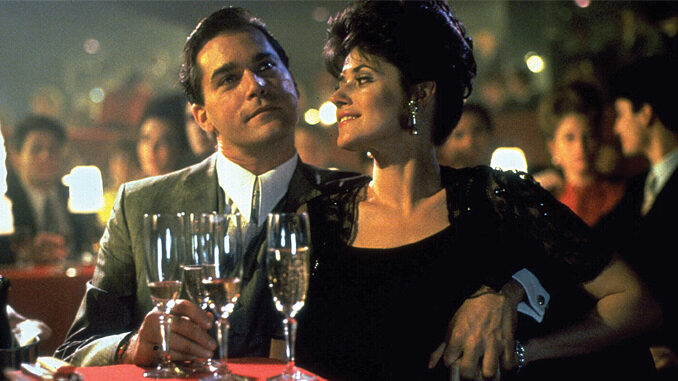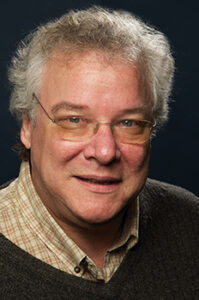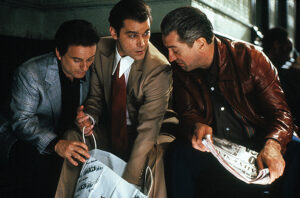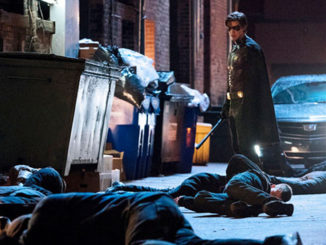
by Kevin Lewis
Almost 25 years after its premiere, GoodFellas (1990) is still a shocking movie about organized crime. Its characters are depicted as stone-cold predatory and crazy, without any redeeming qualities. Martin Scorsese, who directed and co- wrote the film, knew this world intimately; he grew up in New York’s Little Italy, the cradle of organized crime lords in the city at the time. The film did not experience the box office bonanza that greeted The Godfather (1972) and Godfather II (1974), or the television ratings of The Sopranos (1999-2007) because it did not mythologize or sentimentalize its gangland characters. The actors cast in key roles are deglamorized and ordinary, blending so well into suburban and neighborhood life that you wouldn’t suspect them of hiding dead bodies in their car trunks.
GoodFellas won Best Picture and Best Director accolades from such groups as the New York Film Critics Circle, the Los Angeles Film Critics Association and the National Society of Film Critics. But despite nominations in those categories by such organizations as the Directors Guild of America, the Golden Globes and the Academy of Motion Picture Arts and Sciences, those awards preferred to honor the safe, Native-American period film Dances with Wolves, directed by Kevin Costner, that year. However, GoodFellas’ Joe Pesci did win the Academy Award for Best Supporting Actor, while co-star Lorraine Bracco received a nomination for Best Supporting Actress. The film editing of Thelma Schoonmaker. ACE, was also Oscar-nominated, as was Nicholas Pileggi and Scorsese’s screenplay.

The movie, as well as the book from which it was adapted, were based on the true exploits of Henry Hill (Ray Liotta), a gangster in the Lucchese crime syndicate, and his re-named-for-the-film compatriots Tommy DeVito (Pesci), Paul Cicero (Paul Sorvino) and Jimmy Conway (Robert De Niro) over a period ranging from 1955 to 1980. Hill testified against his crime family and entered the witness protection program with his wife and children.
The term “goodfellas” was used for the movie as a pseudonym for “wiseguy,” to distinguish it from the television series Wiseguy (1987-90), based on the 1986 non-fiction book Wiseguy: Life in a Mafia Family by Nicholas Pileggi (the same source material as the Scorsese film), and a prior, unrelated film called Wiseguys (1986), directed by Brian De Palma.
Scorsese’s longtime re-recording mixer Tom Fleischman, CAS, regards GoodFellas as a towering assignments. With his encyclopedic mind for the sounds of urban life — a blend of street noises, loud talking, overlapping dialogue, profanity and music — Fleischman appreciates the discordancy of the soundtrack, and orchestrates what he hears and observes into a sort of symphony.
As with his director, music has always been a primary interest for Fleischman. Scorsese has an incredible mental filing cabinet of pop tunes, folk melodies and jazz pieces, which he can connect to any dramatic situation in his films; his movies are populated by songs that drive, underscore or comment on the action — all of which makes a mix for Fleischman a delight rather than just a challenge. With Scorsese films, “I leave the sound studio looking forward to the next day’s work,” he confesses.
According to the re-recording mixer, GoodFellas was structured around doo-wop and pop songs. Scorsese always brings in recordings from his vast collection and conceives scenes built around them. “The film is edited precisely to the music,” Fleischman says. What happens if Scorsese changes his mind and substitutes another song? “That does not happen,” Fleischman replies. “Everything is an emotional decision for Marty.” Fleischman adds that the psychological tone of the scene is set by a particular song, which becomes the subtext of the conceived scene: “He’s used pop music as score in GoodFellas, Casino [1995] and The Wolf of Wall Street [2013]. Marty’s using music that he’s known all his life. It’s a methodology that he uses to advance the story.”
To achieve this seamless mixing, Fleischman works closely with editor Schoonmaker, with whom he’s collaborated for almost 30 years. “Thelma always comes to the mixes,” he says. Other longtime collaborators he mentions are sound editors Phil Stockton, MPSE, Eugene Gearty and Skip Lievsay.

Fleischman likes to experiment with sound levels on films, and GoodFellas was no exception. “I’m always manipulating the sound; I have the fader on all the time,” he explains. “The soundtrack is a tapestry, it’s like a symphony, and it’s the underpinning. There are very few scenes in GoodFellas that do not have music playing as score.”
Fleischman is very proud of the connecting scenes where Tommy and Jimmy beat Billy Batts (Frank Vincent) to death, stuff his corpse in a car trunk, have a big Italian meal with Tommy’s unsuspecting mother (Scorsese’s own mother Catherine), ask her for her carving knife, and go on to bury Billy upstate. On the soundtrack is the Crystals’ “Da Doo Ron Ron,” followed by Donovan’s “Atlantis.”
The juxtaposition of the pop songs with the on-screen action results in a sinister effect, as most of the film is composed of dark interior scenes: restaurants, basements, Tommy’s mother’s kitchen and even the basement den where Tommy shoots the neighborhood busboy because he laughs at a joke. The songs are wistful, romantic songs, and the characters and their actions appear more depraved and despicable in comparison.
A favorite scene of Fleischman’s is the tour-de- force tracking shot that opens the film, where Henry seduces Karen (Bracco) with his perceived “made man” power. Throughout the shot, the song “Then He Kissed Me” (the Crystals again) is the underscore, brilliantly mixed by Fleischman with kitchen sounds, barked instructions, conversation between the maître d’ and Henry, and the looped-in sounds of the customers.
“The memorable thing about the Copacabana scene in GoodFellas is that the entire scene was done in one shot with no cuts,” Fleischman reminds. “It is a tracking shot that follows Henry and Karen from the street outside the club, down the entrance stairs, past several extras — some of whom Henry trades quips with — through three rooms of the busy kitchen with busboys, waiters and chefs doing frantic kitchen business in and out of the shot as our characters walk past, out into the nightclub where space is cleared in front of the stage and a table is brought out for them, at which point they sit and have a conversation, trading pleasantries with a table full of ‘goodfellas’ across the room. Then the band plays a fanfare, Henny Youngman comes on stage and lets go with a couple of one-liners, end of scene. All done in three minutes, one shot, no cuts, with ‘Then He Kissed Me’ as the musical accompaniment.
“It was so much fun to mix that scene,” he adds. “Every line of dialogue was important to Scorsese, and in between the lines he wanted to hear the beat of the music, the lyrics of the song, the sound of the kitchen, waiters and cooks calling orders, things being chopped, lines of dialogue — all had to poke through the music at the right balance. There was not much Foley, maybe a bit in the kitchen, and hardly any ADR. Most of what you hear under the music is original sync production track! I think one of the guys he passes in the hallway was ADR, and there probably was some loop group in the kitchen and the nightclub. Other than that, it was just production track and music — but the scene is full of energy and life.”
Another memorable sequence is the establishing shot of Bensonhurst, with Paul Sorvino on his stoop, and the scene following inside the house. Fleischman captured the covert street noises and the mystique of that anonymous-but-cowed neighborhood, which made visitors to the neighborhood really feel like outsiders.

Fleischman also talks about the film’s climax. “One of the favorite mix experiences of my entire career was the scene in GoodFellas that leads up to Henry’s arrest,” he explains. “In this sequence, he is doing a lot of things at once: preparing a dinner, picking up his nephew, buying and delivering guns to Jimmy, packing up a cocaine shipment, and trying to stay ahead of the helicopters that are always around him. It is a frantic, 18-minute sequence of dialogue, voiceover, music and sound effects, in which at every particular moment there was something important that needed to be heard in the track.”
As Schoonmaker boldly weaved the rapid, jump-cut images shot by cinematographer Michael Ballhaus, ASC, into a fast-paced visual nightmare, Fleischman added the finishing touch to the soundtrack, mixing the music into a psychedelic soundscape that so jarred cinema audiences of the time — already feeling as jumpy and paranoid as Henry from the visuals — that some literally fled the theatre.
“The scene was scored with a multitude of never-ending musical clips from Muddy Waters, the Who, Mick Jagger and Ry Cooder, and the Rolling Stones, and each clip needed to be carefully timed and interwoven with the other elements of the track,” Fleischman elaborates. “My favorite moments in that sequence were when Henry slams down the trunk of his car and Cooder’s slide guitar lick from ‘Memo From Turner’ kicks off the insanity — and again when the Who’s ‘Magic Bus’ scores the moment that Henry nearly rear-ends the car in front of him, with the sounds of brakes squealing and feet stomping on pedals, accompanied by Roger Daltrey and Pete Townshend singing, ‘I want it, I want it, I want it, I want it…but you caaaaaaan’t have it!’”
Another moment that gave the mixer goosebumps was when Henry and Karen are packing up cocaine for shipment. “Henry takes a huge snort of coke, and the sound of him snorting kicks off Muddy Waters’ ‘Mannish Boy,’” Fleischman relates. “It was just a thrill to mix — such amazing filmmaking.”





